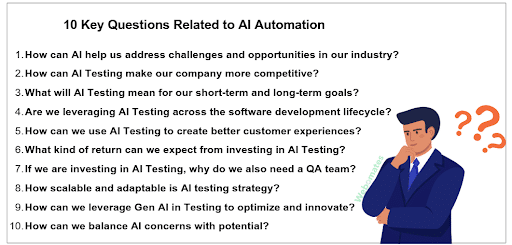Accelerate Success with AI-Powered Test Automation – Smarter, Faster, Flawless
Start free trialA CEO’s role – AI Testing bridges the gap between a CEO’s strategic vision and achieving operational execution.
What’s in it for me? This single question sparks a series of follow-up questions, ultimately leading to the best outcomes.
CEOs have seen mature companies successfully drive AI initiatives and achieve superior business outcomes from their investments. Driving a mindset shift to increase involvement from all stakeholders is a continuous effort. But a CEO is the first to initiate anything new. This article is a guide for CEOs to cut through the hype around AI and understand what creates value now and in the future.
10 Key Questions Related to AI Automation

To navigate this transformation, they can address 10 critical questions that explore the opportunities, challenges, and strategic decisions involved in leveraging AI for testing. And unlock value and benefits.
In this quest for strategic agility, artificial intelligence (AI) has emerged as a game-changing tool. AI empowers businesses to thrive beyond their competitors by providing fast-paced, accurate, and real-time insights. By integrating these capabilities, CEOs can foster a culture of innovation and efficiency, ensuring that their organizations remain at the forefront of the AI revolution.
1.How can AI help us address challenges and opportunities in our industry?
AI is a transformative force across industries, offering solutions to long-standing challenges and unlocking new opportunities for growth, efficiency, and innovation.
- The defense sector can use AI to enhance the testing of IoT-connected equipments, such as satellites, drones, and radars, to ensure improved reliability, precision, and security of crucial defense operations. It can also strengthen their cybersecurity and protect their assets, ensuring that sensitive data is secure.
- Healthcare needs help managing and analyzing patient data efficiently. AI-powered tools can streamline such processes and provide personalized medicine through AI-driven insights.
- Financial institutions need fraud detection and prevention mechanisms. AI systems can analyze transaction patterns in real time to flag anomalies and prevent fraud.
- Retail and E-commerce applications face challenges in understanding customer preferences at scale. AI can provide enhanced omnichannel experiences and analyze browsing and purchase history to suggest relevant products.
2.How can AI Testing make our company more competitive?
AI enables everyone across all levels to work smarter. By automating repetitive tasks, AI allows developers and QA teams to focus on complex, value-driven tasks. Companies using AI to streamline their testing processes can release products faster, with fewer defects, and at a lower cost—giving them a significant edge over competitors. By having AI-driven insights, decision-makers can enable smarter decision-making, improving customer satisfaction and loyalty.
3.What will AI Testing mean for our short-term and long-term goals?
Automating time-consuming and repetitive tasks can be short-term and application-specific goals. It helps you with improved efficiency, enhanced coverage, or reduced defects.
As a CEO, you must have a vision for long-term goals like quality at scale, data-driven decision-making, and maintaining a competitive advantage. AI testing platforms generate actionable insights from test data, enabling smarter decisions. Teams can also innovate faster and deliver superior customer experiences while continuously learning and improving through historical data.
4.Are we leveraging AI Testing across the software development lifecycle?
As a CEO, you’re always looking for ways to drive operational efficiency and reduce costs while ensuring that your company remains competitive.
One powerful strategy that can help you achieve these goals is shift-left testing—where testing isn’t limited to post-development phases. Teams can identify and fix defects early—when they are cheaper and easier to resolve. This results in cost savings over time, both in terms of effort and cost.
Also, by investing in defect prediction tools like the AI Defect Predictor tool, you will save on the escalating costs of post-production fixes and improve your product quality. You can also seamlessly incorporate AI-driven testing into CI/CD workflows for continuous quality assurance.
5.How can we use AI Testing to create better customer experiences?
Does your product meet the user’s needs?
Product development involves careful planning, innovation, automation, time, and resources. AI Testing can add value to business applications, through its varied technologies and will revolutionize the customer experience.
AI Testing provides a higher quality, more reliable product to market faster, provides a richer, more positive experience for the customer, and thereby a competitive advantage for the company.
Read on to learn the Key AI Testing Solutions To Improve Your Product’s End-User Experience.
6.What kind of return can we expect from investing in AI Testing?
The potential AI returns span across financial savings, operational efficiency, strategic benefits, and enhanced customer satisfaction.
- Financial – AI testing helps teams predict and identify defects earlier saving on post-production defect fixes. It also automates repetitive tasks reducing the labor costs.
- Operational – AI drives automation, enabling teams to perform tasks faster and with fewer errors leading to productivity gains. AI-powered testing platforms enable faster testing cycles.
- Strategic – AI accelerates development and testing enabling faster releases and helping teams stay ahead of their competition.
- Customer satisfaction – AI transforms customer experiences by offering personalized experiences, content, and offers, improving customer satisfaction.
7. If we are investing in AI Testing, why do we also need a QA team?
Yes. With AI-based automated testing, you can increase the overall depth and scope of tests, find and fix defects resulting in software quality improvement. But not all defects are due to a developer’s coding errors that can be fixed with AI.
What happens when there are zero defects in the code but it still fails? That’s when you will need the expertise of a QA team where they can Go exploratory – A place where no scripted test has gone before! They can pinpoint how a feature works under various conditions and that could be against different devices, browsers or operating systems as well.
It’s best when you scrutinize the potential risks by combining exploratory testing with regression testing.
8.How scalable and adaptable is AI testing strategy?
CEOs should be ready for anything – handle increased traffic, new features, ramping up and down among evolving business needs.
A robust testing strategy should be capable of scaling as data volumes increase and adapting to changes in the model or business context. CEOs should look for testing solutions that are flexible and future-proof.
9.How can we leverage Gen AI in Testing to optimize and innovate?
As per Gartner’s top predictions for 2024 and beyond show every strategic conversation needs to include GenAI.
Gen AI can analyze existing datasets and create comprehensive test cases that cover many scenarios, reducing manual effort and improving coverage. It can also generate realistic and diverse test data, including positive and negative cases, and edge cases to ensure robust system validation.
How can we balance AI concerns with potential?
When it comes to integrating AI testing into strategic processes, it’s natural for business leaders to have reservations about the complexity of adopting AI testing, data privacy, and security. However, its benefits outweigh its concerns. Automating routine tasks frees up resources to focus on creative and innovative tasks thereby increasing productivity. It provides data-driven insights that improve strategic decision-making.
CEOs should assess all tools and invest in partnerships that align with their business goals.
Webomates Point of View
Webomates believes that A CEO plays a pivotal role in integrating AI into software testing to enhance agility and maintain competitiveness. By embracing the AI opportunity, leaders can foster exponential growth and drive innovation.
At Webomates, we believe in the power of human and machine collaboration, where the human workforce is augmented by AI to become more efficient and productive.
Testing as a Service is a supplement to traditional testing that allows the test team to focus on higher value activities like defect resolution, quality analysis, etc.
Tags: AI Testing, AI Testing Questions, AI Testing Questions for CEOs, Software QA, Software Testing

Leave a Reply